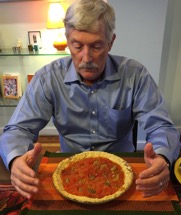
— By Deborah Kesten, VIP Contributor at Thrive Global
Eating mindfully can help to transform meals into a restorative, relaxing escape. I created the Whole Person Integrative Eating (WPIE) Guided Meal Meditation so you can infuse each meal with all the ingredients of Whole Person Integrative Eating: fresh food, positive feelings, mindfulness, gratitude, loving regard, an amiable atmosphere, sensory regard, social connection, and more. Each time you “flavor” meals with the WPIE elements that nourish body, mind, and soul, you will be poised to enjoy your food more, simply relax, and unplug from the outside world.
The intention behind the WPIE Guided Meal Meditation is to show you how to use mindfulness meditation to connect to food and eating in a way that balances your physical, emotional, spiritual, and social well-being. It is a restorative recipe that, our research has revealed,1-3 can curtail emotional eating, and help you relax and feel peaceful and serene.
Here are the key steps you’ll need to practice the WPIE Guided Meal Meditation. And to turn each meal into a retreat.
Begin by relaxing. To start the heart dance between you and your food, position yourself the same way each time you dine. Whatever position you choose, over time it will become a gentle reminder that leads you into the meditation. Now simply relax by inhaling deeply, then exhale slowly. Do this three times.
Visualize. Next, envision a ball of liquid golden light several inches above your head. Then imagine it melting, then flowing through your head and body, down to your feet.
Create a mudra. Continuing to envision golden light emanating from your body—especially from your heart center and hands—position your hands as if there were a small beach ball hovering just over your food and your hands are holding that beach ball.
Choose fresh foods. Holding regard for food in your heart, focus on what you are eating. Is the food in front of you fresh and whole? Does the meal include fresh, whole plant-based foods (vegetables, fruits, whole grains, beans and peas, nuts and seeds)? And/or lean fish, poultry or meat? Or is it fast food and processed? In other words, have you taken the time to choose food that is a positive life force, a nurturer, a gift that recharges and sustains?
Unite socially. If you are dining with others, envision a ray or thread of the golden liquid connecting your heart center to the heart center of the other person or people at the table. If you’re alone, connect the golden thread to a memory of a person, or people, with whom you’ve enjoyed memorable meals.
Tune into feelings. Continuing to relax and breathe deeply, identify how you are feeling. First, are you feeling hungry? And if so, how hungry: a little, somewhat, or a lot? Use this knowledge to make a decision about how much or how little you want to eat. Also, are you filled with positive, loving emotions? Or do you need to release negative emotions, such as anger and anxiety, before eating?
Practice mindfulness. Eating mindfully includes being aware of what, where, with whom, and when you’re eating. It also includes awareness that the senses play a significant part in helping you to remain meditative. Look at the food in front of you. “Taste” the colors first. Is there a lot of food? Or not? Is the fragrance and flavor of the food sweet or sour? What kinds of sounds surround you? Are you—and the surrounding atmosphere—calm and quiet? Continue to focus mindfully on the food and environs throughout your meal.
Be appreciative. Continuing to hold the ball mudra while remaining in a state of calm, relaxed appreciation—for a person or place, or especially for the food before you—express your gratitude with a mantra, blessing, or prayer of choice, or simply say “thanks” for the food in front of you.
Create connection. Connecting with food calls for evoking loving intention and then projecting it onto the food. To do this, focus again on the golden energy flowing through you. As your hands continue to surround both sides of the dish, through visualization, project rays of this golden light into your food – emanating from your hands into the food, and from your heart center into the food. In this way, you “flavor” both yourself and your food with loving intention.
Now, feeling relaxed and calm, with awareness of your feelings and surroundings, with mindfulness, a sense of loving regard, and nonjudgmental, appreciative attention on your food, it is time to enjoy the restorative experience of whole person integrative eating.
References:
- Larry Scherwitz and Deborah Kesten, “Seven Eating Styles Linked to Overeating, Overweight, and Obesity,” Explore: The Journal of Science and Healing 1, no. 5 (2005): 342–59.
- Kesten D, Scherwitz L, “Whole Person Integrative Eating: A Program for Treating Overeating, Overweight, and Obesity,” Integrative Medicine: A Clinician’s Journal 14, no. 5 (October/November 2015): 42-50.
- Deborah Kesten, Whole Person Integrative Eating: A Breakthrough Dietary Lifestyle to Treat the Root Causes of Overeating, Overweight, and Obesity (Amherst, MA: White River Press, 2020).


